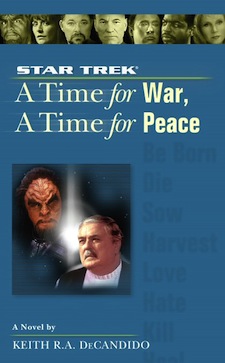When I picked up Keith R. A. DeCandido’s A Time for War, A Time for Peace (2004), I had no intention of blogging about it. I can’t tell whether the title comes from the Old Testament or from the Pete Seeger song. It’s book nine in a nine-book mini-series, and I object to anything nine books in length being described as a “mini-series.” More significantly, I haven’t read the first eight books.
Jumping in at book nine to say several hundred words about the worth and quality of a work doesn’t feel like fair play, but I’m going to do it anyway. I picked up this book as part of my personal mission to read everything ever written about Deltans. Although he doesn’t have much to say about Deltans, DeCandido has written a fun and fabulous book that completely drew me in.
It has all the things that make Star Trek worth reading:
1. Worf does what Worf does best.
Worf is a Klingon ambassador, which seems like it could be pretty tedious for everyone involved. But his embassy is attacked, and instead of high-tailing it out of there and making a plan to escape the Klingon Empire on a bicycle or something, he takes out the terrorists with an off-brand phaser. At least, I assume it’s an off-brand phaser. It’s Breenian, which is something that must have been explained at some point in one of the eight books I didn’t read. But it doesn’t matter that I don’t know that, because this is an exciting action scene with high stakes for both Worf and the story.
2. I wish I worked on the Enterprise.
The characters in Star Trek: The Next Generation spend roughly half of their waking hours working together in the same room. Periodically, they all leave that room, where they were working, and go sit in another room, to talk about their work. They sit in a conference room a few feet from their actual workplace, without muffins or eye-rolling or obvious personal animosity, and solve problems. Facing a performance audit, they simply plan to put their best foot forward. No one talks about performance metrics, best practices, or implementation rubrics. They are delightfully free from jargon and bullshit. Perhaps because the elimination of these streamlines a lot of future business, an intergalactic presidential election only takes a month. The crew of the Enterprise-E also enjoys delightfully futuristic wedding planning, which focuses entirely on how to make everyone happy since money is not a consideration. It’s difficult and traumatic anyway, but as a person who once broke down in tears because there were mushrooms on a proposed catering menu, I don’t see how you can avoid that.
3. Wesley shows up naked.
I have always thought that the entire notion of Travellers is weird. Charlie X and Q had phenomenal cosmic powers, and both of them were intensely annoying. I know there’s a substantial contingent that feels that Wesley Crusher was also annoying—I am not part of that. If my parents worked on a starship, I would have been just like him. Wesley’s scene in this book highlights all the problems that being a Traveller could cause for a person who tries to be thoughtful. He gets confused about the location of Riker and Troi’s wedding and shows up on Earth prepared for the Betazoid ceremony, where nudity would be expected, thus interrupting an important moment in the glacial progress of his mom’s relationship with Picard. This is not a mistake you make if you have to book a flight and a hotel. Though I am also not part of the contingent that wants to see Wes naked, I appreciate this critique of the notion that life would somehow be easier or more fun if only we could unchain ourselves from the natural functioning of time and space.
4. Scotty.
Not only has he been rescued from the transporter buffer, he’s looking out for the Enterprise crew and dispensing career advice. He’s amazing, as always. One of the great injustices of Star Trek is that we have never seen Scotty’s funeral. That’s only forgivable if we get to see the man himself, alive, well, sharing a drink, and reminding us of who we are and what makes us happy. Scotty makes me happy, most especially in the way he’s still alive.
5. Deltans.
Most depictions of Deltans stick to three points: They’re bald, they’re sexy, and they’re bad for you. DeCandido adds that they need water reclamation technology from a species they once went to war with. So now I know that, although they’re good at math, the Deltans aren’t so good at engineering, that their planet has to contend with periodic or regional drought, and that Deltans either do not or cannot use their pheromones to manipulate all other species. That’s a lot of additional dimension added to the characterization of Deltans, in less than two sentences.
Star Trek: A Time for War, A Time for Peace is available from Pocket Books.
Ellen Cheeseman-Meyer teaches history and reads a lot.










